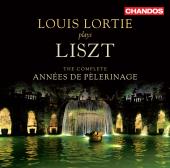| Label: CHANDOS
Catalog: CHAN10662
Format: CD Louis Lortie (piano)Franz Liszt: The complete Années de Pèlerinage, including supplement to Year 2: Venezia e Napoli Juno Nominee 2012 - CLASSICAL ALBUM OF THE YEAR: SOLO OR CHAMBER ENSEMBLE
Canadian pianist Louis Lortie has been praised for the fresh perspective and individuality he brings to a deliberately broad spectrum of the keyboard canon. He studied in Montreal with Yvonne Hubert (a pupil of French pianist Alfred Cortot), in Vienna with the Beethoven specialist Dieter Weber and subsequently with Schnabel disciple Leon Fleisher, among others. Lortie has performed the complete works of Ravel in London and Montreal for the BBC and CBC, and is also known for his interpretations of Chopin. Following a recital of Chopin’s complete Études in London’s Queen Elizabeth Hall, the Financial Times wrote: “Better Chopin playing than this is not to be heard, not anywhere.” Lortie has performed a series devoted to the keyboard, chamber and vocal music of Brahms and Schumann for CBC. He often performs solo, chamber and concerto works by Thomas Ades.
Wholenote Discovreies - April 2011
A new Chandos double-disc set by Louis Lortie features the entire Années de Pelèrinage, including an addendum to the second set, Italie. Lortie has made a considerable name for himself since winning first prize at the Busoni Piano Competition in 1984, and a major prize at the Leeds Competition... Now based in Berlin, he continues to enjoy international fame through concerts and recordings. The three sets of Années – based on Liszt’s voyages to Switzerland and Italy - are gigantic in scope, and I would deem few pianists are able to interpret this music convincingly. Needless to say, Lortie does so brilliantly. As befits this repertoire, his approach is bold and impassioned, demonstrating a herculean technique. The Vallée d’Obermann from the first set presents technical challenges that would make the average pianist wince, but Lortie brings it off with aplomb. On the other hand, his treatment of such pieces as the Sonetto 47 and 123 from the second set, Italie, is elegantly understated. Bringing the disc to a rousing conclusion is the flamboyant Tarantella, music requiring almost superhuman powers. Is it any wonder that Liszt was sometimes regarded as Mephistopheles himself? Richard Haskell
The virtuoso pianist and exclusive Chandos artist Louis Lortie here performs all three books, or ‘Years’, of Liszt’s Années de Pèlerinage (Years of Pilgrimage), a work rarely recorded in its entirety. Lortie has made more than thirty recordings for Chandos, covering a repertoire from Mozart to Stravinsky. His recording of Beethoven’s ‘Eroica’ Variations won an Edison Award; his disc of works by Schumann and Brahms was judged one of the best CDs of the year by BBC Music, and his interpretations of Liszt’s complete works for piano and orchestra and of Beethoven’s complete piano sonatas were both selected as Editor’s Choice in Gramophone.
Liszt was an artist by nature. He seemed to feel and be affected by external influences far more deeply than most, and he was a master at translating these feelings into music. The first Year of the Années de Pèlerinage, a reworking of pieces from his earlier Album d’un Voyageur, was inspired by his travels in Switzerland as a young man. In this work, the music does not depict or describe particular scenes or landscapes, rather it attempts to communicate the feeling that Liszt experienced when he saw them, his ‘strongest sensations and most lively impressions’.
‘Chapelle de Guillaume Tell’, for example, depicts a fourteenth-century Swiss hero through a broad and stately theme that quotes a Swiss Alpine horn melody with trumpet calls, echoes, and tremolos. ‘Au lac de Wallenstadt’ depicts the gently rising and retreating waves of the lake, over which Liszt places a theme of beautiful simplicity.
The second Year was inspired by the art and literature that Liszt encountered on his travels in Italy. ‘Sposalizio’
was inspired by Raphael’s painting The Marriage of the Virgin in the Brera in Milan, and ‘Il Penseroso’ by Michelangelo’s statue on the tomb of Lorenzo de’ Medici in the church of San Lorenzo in Florence.
The third and last Year of the Années de Pèlerinage was written much later, when Liszt was in his sixties, and at a time when both the man and the style of his music had undergone a vast change. The pieces show far more simplicity in the treatment of the musical components and often convey a mood of despair and stark austerity.
From the outset, Liszt knew that his Années de Pèlerinage was unlikely to appeal to the masses. In his own words, the work was ‘written for the few rather than the many – not ambitious of success, but of the approval of that minority which conceives art as having other uses than the beguiling of idle hours, and asks more from it than the futile distraction of a passing entertainment’  Price: $25.98 Price: $25.98 |
 Price: $25.98
Price: $25.98











